Prince of Drones
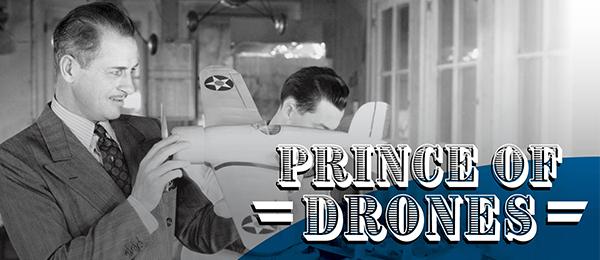
Written by Kimberly Pucci
The Reginald Denny Story
As seen in the July 2021 issue of Model Aviation.
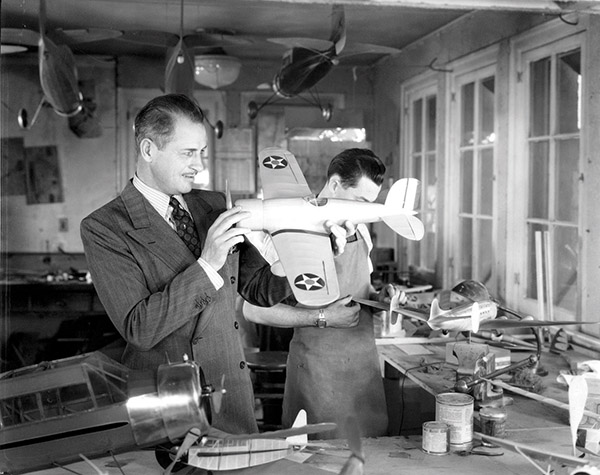
Reginald "Reg" Denny was born into a family of Shakespearean actors at the same time when Nikola Tesla invented electricity and Edison created cinema. At age 6, "Master Reginald Denny" performed his first role as a prince before Queen Victoria. He was a sensation throughout London, but when his mother died, he was sent to an orphanage. There, he’d watch "aeroplanes" fly overhead at the dawn of flight and carve models of the curious aircraft.
He also learned the art of falconry and sketched the aerodynamic raptors, intrigued with Tesla’s invention of "telemetry." However, while studying for his matriculation exam, Reggie had a disagreement with the school’s headmaster, and off he flew.
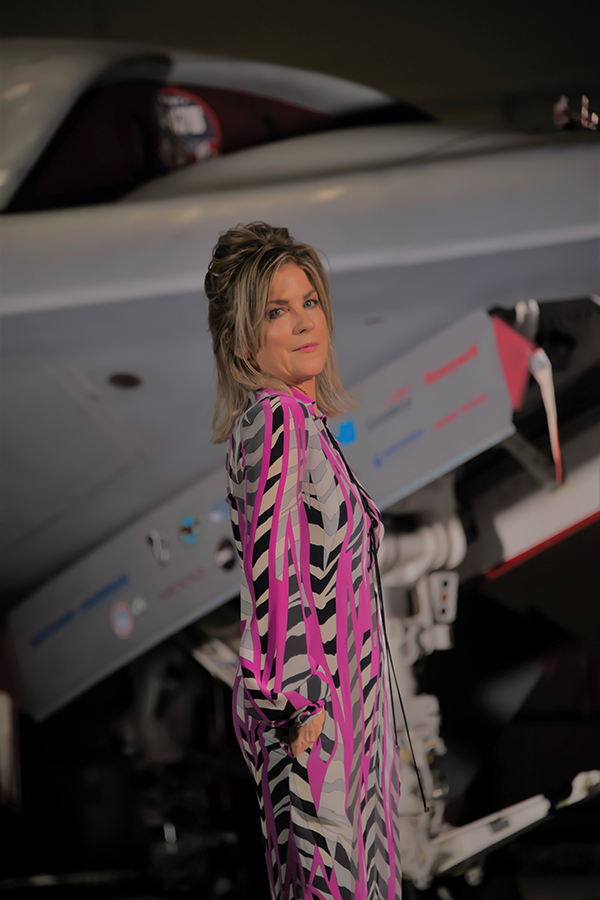
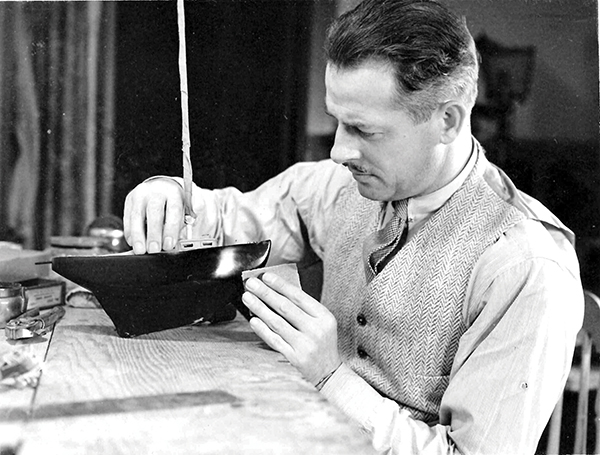
Homeless on the streets of London, he made his way into the National Sporting Club, where Sir Harry Preston taught him the pugilist art of boxing. At age 17, Reg won several heavyweight championships, until he was knocked out and suffered a broken jaw. For a safer living, he toured the music halls of England, where producer Henry Harris noticed the charismatic singer and took him to America. Reg was a hit on Broadway until the Titanic sank, taking his producer and the show down with it.
Returning to England on Titanic’s sister ship, Reg landed a job as baritone with the Bandmann Opera Company. He sailed with the musical troupe to India, where he performed for Mahatma Gandhi, who told him, "always sing with your eyes to the sky."
With the onset of World War I, Reg joined the British Army, which merged with the Royal Flying Corps. In the Royal Air Force, Lt. Reginald Denny became a fighter in more ways than one. He refined his pugilist talents to win the first Brigade Boxing Championship, trained as an aerial gunner, and became one of the first pilots to fly warplanes in action. After a friendly fire crash over the English Channel, Reg returned to his childhood hobby of sketching and carving model airplanes, this time for simulating dogfights.
When the war ended, he sailed back to America to get work in the only money-making craft he knew. The medium of "silent films" had emerged at the original New Jersey studios, but when the homeless and injured war veteran tested for the big screen, he was told by several pioneer producers that he’d never make it because of his "crooked mouth, waddle of a walk, and blah personality."
Back on Broadway in Shakespeare’s Richard III, Reg rescued costar John Barrymore from an on-stage breakdown, and yet another show was shut down. He decided to give the "flickers" one more try and used his talents to break into the film market with a magazine series called The Leather Pushers. Because boxing on film was illegal, Reg had a hard time getting anyone to look at his reels, until Universal Pictures founder Carl Laemmle discovered him. In 1922, the iconic film producer moved the charismatic boxer with the crooked smile to his Universal City Studios in the Hollywood Hills.
There, Reg brought both boxing and farce together on the big screen to become Universal’s top comedic-action silent film star throughout the Roaring ’20s. He then resumed his flight path in Los Angeles, where a team of barnstorming daredevils dubbed the movie star as their "13th Black Cat." Reg bought a Curtiss Jenny biplane from racecar driver Bon MacDougall and had two retired Sopwith Snipes shipped from England, which he flew in Universal’s The Lone Eagle and loaned to Howard Hughes for Hell’s Angels.
Like Howard, Reg was an adrenaline junkie and never used a stunt double while boxing, racing cars, or flying airplanes. He subsequently lost his front teeth and broke nearly every bone in his body. As a result, Universal wouldn’t let its movie star fly anymore, so he’d carve miniatures to look like real ones on the screen and let Howard Hughes use his valuable Snipes for background shots in his film.
At the onset of the 1930s, Reg segued from silent films into the new world of sound pictures, or "talkies." He starred in several at MGM, kicking off with Cecil B. DeMille’s musical thriller Madam Satan, with Bette Davis in RKO’s Of Human Bondage, and in John Ford’s all-male cast hit, The Lost Patrol; however, when audiences heard his refined British accent, they were confused because it didn’t fit his "all-American hero" persona.
At age 40, Reg was demoted from one of the world’s top leading men to supporting roles at a smaller salary. With a new family to support, three airplanes, two race cars, two yachts, a home in the Hollywood Hills, and a beautiful cabin in Running Springs, California, with a stable of horses, Reg was going broke.
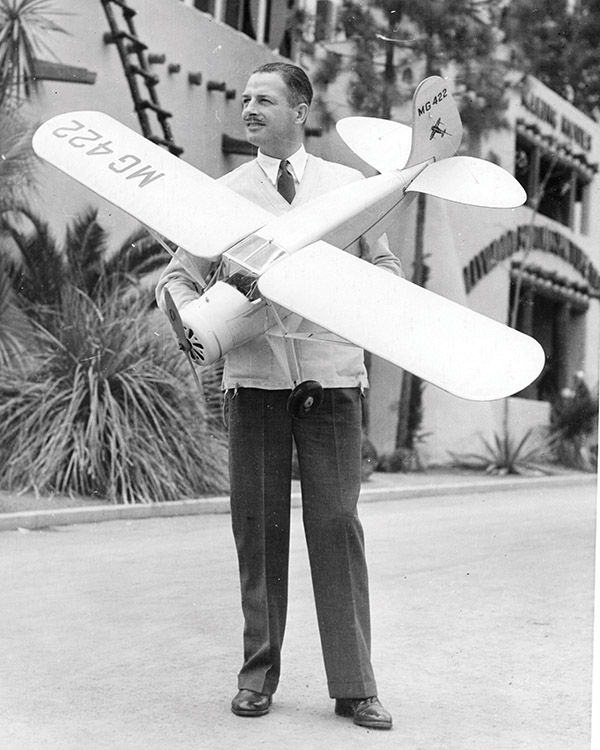
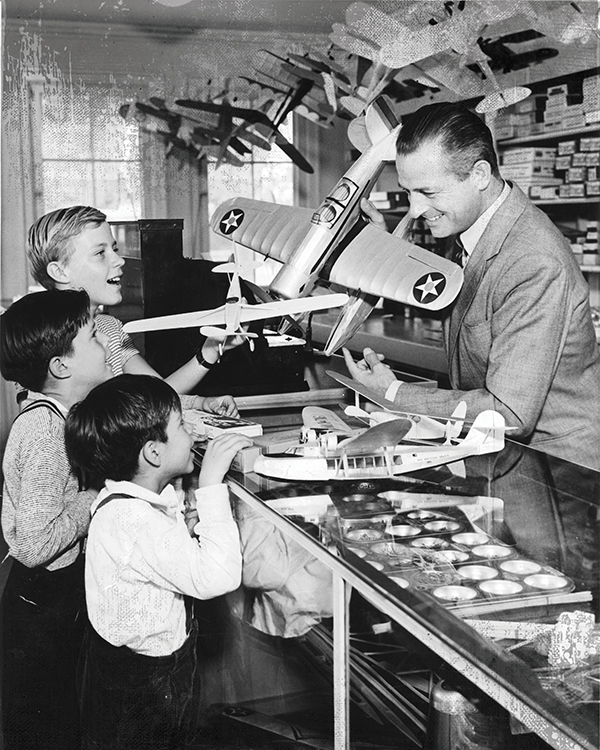
With the Great Depression upon him, he met an oil tycoon who’d lost his fortune and found purpose in carving a model ship for his young son. Reg listened to the oilman and decided to "whittle away his worries." He carved a beautiful schooner for Reggie Jr. and whittled small versions of his full-scale airplanes.
The models looked fine on shelves, but he wanted to elevate them into action. In his home garage, Reg created miniature airplanes. He built a transmitter for radio communication to the moving parts and installed a small gas-powered engine for power, lift, and speed.
At his mountain cabin, he’d built a runway on which to land his full-scale airplanes; he decided to test his smaller, remote-controlled versions there. After several months of practice (and crashes), he took off, performed stunt maneuvers, and landed his models with ease.
Back in Hollywood, Reg donated one of his British warplanes to Los Angeles High School to encourage youth to fly. In his home basement, he formed his own flying school, using model airplanes to teach kids the science of aerodynamics. Word of the movie star’s "remote control" flight simulator school got out in the Los Angeles Times and retail chain Montgomery Ward asked to sell his miniatures via mail order catalog.
To sell to the public, he formed Reginald Denny Industries then opened Reginald Denny’s Hobby Shop at 5751 Hollywood Boulevard. There, he hired staff to make and sell model kits for the likes of William Randolph Hearst, and created signature models, including his 6-foot Dennyplane with its Dennymite engine, Dennywheels, and Denny Junior for people such as Mickey Rooney, Jane Withers, and Freddie Bartholomew.
The child actors flew in highly publicized model airplane competitions at Mines Field, now known as Los Angeles International Airport. During a model airplane competition at Mines Field, Reg overheard an Army officer complain about the unreliability of "target tugs" for antiaircraft gunnery practice. He suggested his RC airplanes could be used as targets instead of full-scale aircraft.
In his home garage, he drafted blueprints and designed his Radioplane. He teamed with oil tycoon heir Paul Whittier and hired engineer Walter Righter, who’d developed the Dennymite engines, along with radio ham operator Kenny Case, who developed the new transmitters.
The team built and tested Reg’s radio-controlled airplanes that used a black box with an antenna and a telephone dial to control the aircraft. The pilot wore headphones connected to the transmitter to hear command tones sent to the model.
In 1936, Reg began pitching his Radioplane-1 (or RP-1) to the U.S. Army Air Corps. During the course of two years, he and his team conducted test runs of the RP-1, RP-2, and RP-3 prototypes before military leaders in California, first at the antiaircraft artillery base in San Pedro, then at Twentynine Palms, and finally at March Field.
.</figcaption>
</figure>
<figure class=)
All failed because the Radioplane kept crashing when the speed was increased. Reg, Walt, and Kenny developed larger engines to increase speed while making improvements to the fuselage. To solve the crashing problem, they invented a Parachute Landing System, inspired by Reggie Jr., whereby the 12-foot "drones" would float to the ground and land softly instead of being destroyed.
While running the hobby shop and inventing his Radioplane, Reg continued work as an actor. He starred in several films, including MGM’s Romeo and Juliet, Columbia’s Let’s Get Married, and Paramount’s Bulldog Drummond series. He’d proudly bring his models to studio sets, where he’d entertain the likes of director George Cukor and fellow movie stars Robert Montgomery, John Barrymore, Leslie Howard, and Ida Lupino, as well as using them in the films.
While working on John Ford’s Four Men and a Prayer at Fox, Reg was summoned by Col. George Holloman to meet at the Army Air Corps headquarters in Dayton, Ohio. Before the military leaders, the actor presented his aircraft, stressing that his Radioplane could be of "inestimable value." Not only could his RC airplanes be used for antiaircraft gunnery practice, they could replace manned aircraft for reconnaissance and surveillance, as well as what he termed "aerial torpedoes" in battle.
When Reg wagered military experts that he could hit a bull’s-eye 30 miles away with a model airplane that had a 12-foot wingspan and a payload of 10 pounds of simulated cargo, they thought he was joking. They laughed at the man whom they had known as a comedian and accused Reg of being some "crazy actor." They argued that it was too small, its speed too slow, and an "aerial torpedo" could only be used for indiscriminate area bombing.
Col. Holloman, however, defended Reg’s case. He stated that size and speed could be increased or decreased as necessary, that its expense was a great factor compared with the cost of manned aircraft, and that Reg’s unmanned airplanes could easily be developed as "aerial torpedoes." He demanded that the Radioplane project be given a trial and, after calling for a vote, the Army Air Corps issued Reg a letter of intent.
At the official onset of World War II, the government issued Reginald Denny Industries a contract to test three experimental RC airplanes for antiaircraft gunnery practice. To meet military specifications, Reg and his team developed larger, more powerful engines. To accommodate the faster speeds, they upgraded the transmitter using a joystick instead of a telephone dial, and they refined the Parachute Landing System with a user-friendly switch on the control box to open the fuselage hatch. At the Mojave Desert salt flats, they tested the unmanned airplanes at 120 mph using Walt Righter’s rigged automobiles to create an air tunnel flight simulator.
While designing drones for the military, Reg attained his US citizenship. He was nominated as chairman of the Americanism Educational League and, together with director Hobart Bosworth, he opened a court to bar the Communist Party from all voting polls in the state of California. At the same time, Reg starred with Laurence Olivier and Joan Fontaine in Alfred Hitchcock’s first American thriller and Academy Award winner, Rebecca.
Following the film’s star-studded premiere at Grauman’s Chinese Theatre in the spring of 1940, Reg and his team trailered the three Radioplane RP-4 drones to the Muroc dry lake beds, now known as Edwards Air Force Base (AFB). Before military leaders, the three RP-4s successfully took off using Reg’s newest invention, the Rail-Launcher.
All flew according to military specifications: a 1-hour flight with a climb rate of 500 feet per minute to an altitude of 5,000 feet then a parachute recovery landing within a quarter of a mile from the takeoff position. The historic feat garnered acclaim. Reginald Denny Industries was immediately awarded a government contract for his Radioplane to replace manned aircraft and their full-size targets for antiaircraft gunnery practice.
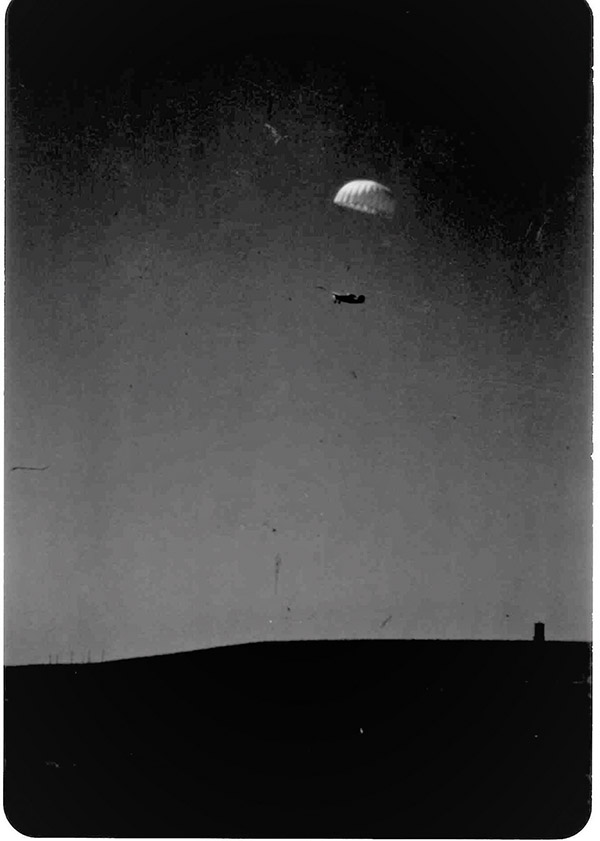
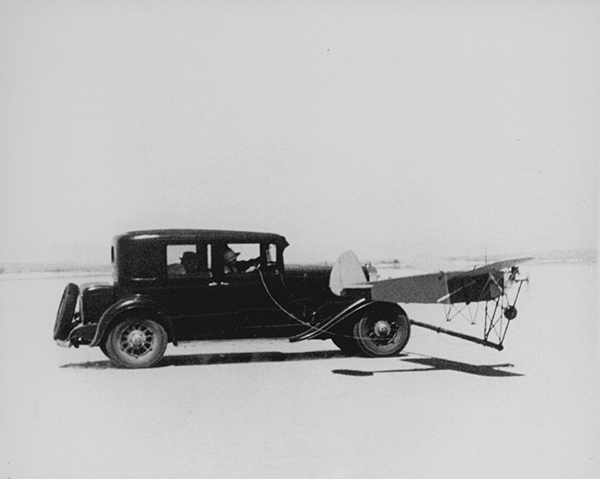
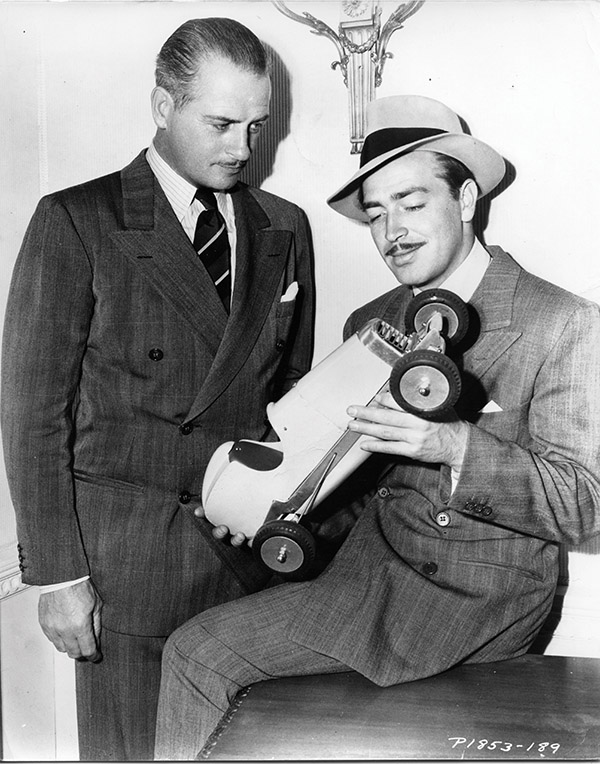
Reg had filed bankruptcy after spending all of his money to build his dream. Now desperate to fulfill the military contract and manufacture his target drones, he sought funding from former Lockheed executive Whitley Collins. On July 1, 1940, along with Paul Whittier, Whitley, and Whitley’s business partner, Harold Powell, Reg formed the Radioplane Company and opened a manufacturing plant at the Van Nuys Metropolitan Airport in California.
The Army Air Corps placed its first order of the RP-4A, which was designated the OQ-1. The following year, the Navy placed its order of the improved RP-5, which was named TDD for Target Drone Denny. The Navy’s TDD-1 was the same as the Army’s OQ-2, only without landing gear. With the Navy’s order, Reg designed an ocean retrieval device he named RPF-1, for Radioplane Flotation-1.
While serving as Radioplane’s vice president, Reg continued to earn a living as an actor. In 1941, and now 50 years old, he starred in several popular WW II films, including Paramount’s One Night In Lisbon, MGM’s Eyes in the Night, in which he played a wartime inventor, and Warner Brothers’ International Squadron, with actor and future U.S. President, Ronald Reagan. Reg not only brought his models to sets for use in the films, he also loved sharing them with fellow actors, including Fred MacMurray. He also gifted Gen. Douglas MacArthur a personalized model for his son.
He shared his Radioplane with Ronald, who was in the U.S. Army Reserve. With the war now in full swing, Ronald was ordered to active duty and sent to various locations with the Army’s First Motion Picture Unit. Ronald asked Reg if he could bring his film crew to the Van Nuys plant and get a glimpse of his drones. While taking pictures of women doing war work, Ronald’s staff photographer noticed one of Reg’s employees and snapped several shots of the auburn-haired beauty holding RP-15 parts. These photo sessions launched Norma Jeane Dougherty’s career from drone assembler to actress Marilyn Monroe.
The world conflict ended with a total of 15,375 target drones made for the military during WW II. With the company’s success, Whitley strategically bought out Paul and cleverly pushed Reg out of the picture. At the same time, Navy Adm. Blandy invited Reg to San Diego for a trial run of Operation Crossroads aboard the aircraft carrier USS Shangri La.
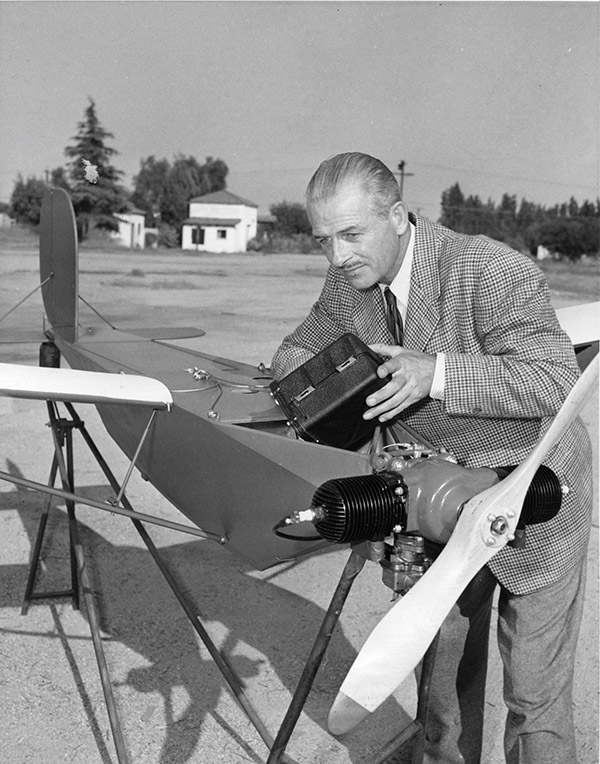
Adm. Blandy was intrigued with Reg’s Radioplane and asked whether the drones could carry a load, as well as test effects of the new atomic bomb. Reg replied that they could indeed carry a load and be operated from a distance to prevent pilot exposure. News of the event was featured in The Los Angeles Times, in which Reg was named "Father of War’s Robot Plane" and quoted the Navy discussing future uses of his invention. Whitley wasn’t happy and ordered the Navy to stop using Target Drone Denny for its designation because he felt that military craft shouldn’t be named after an actor.
Reg continued acting, starring with Danny Kaye in The Secret Life of Walter Mitty and in Mr. Blandings Builds His Dream House with Cary Grant and Myrna Loy. Whitley was again unhappy about "Remotely Reg" working on film sets and discussing his Radioplane with movie stars.
He fired the actor as vice president of the plant, but Reg kept his position as secretary on the board of directors. At the same time, Reg’s friend and fellow aviation pioneer, Jack Northrop, was experiencing similar challenges from executives at his Northrop Aircraft Corporation. After forming the company’s Foreman’s Club and, while developing his Flying Wing, Jack shared with Reg his suspicion of their business partners plotting a takeover.
With the onset of the Korean War, in which Reggie Jr. served, Reg Sr. designed another unmanned aerial vehicle that provided nighttime enemy illumination that he called Flareplane. This time, he filed a patent for his invention and hired Rheem Manufacturing to develop the new drones. Reg sent a formal proposal to the newly appointed U.S. secretary of defense, who responded that the U.S. Army and Air Force would like to put his Flareplane in use as quickly as possible.
In the spring of 1952, the secretary of defense invited Reg to the Pentagon for the Department of Defense’s Joint Civilian Orientation Conference. While in Washington D.C., discussing the future of his drones, Reg was contacted by Jack, who told him to get back to LA because their executives had arranged the sale of Radioplane to Northrop Aircraft Corporation.
With $82 million in orders (roughly $1 billion now) and Reg’s share worth millions, he was paid only $100,000 in the hostile takeover. Both founders were ousted and Whitley assumed Jack’s position as president of Northrop Aircraft Corporation. Soon after, Whitley publicly announced his launch of the RP-71 Falconer with reconnaissance, surveillance, and nighttime enemy illumination—the same features Reg had presented to the secretary of defense with his Flareplane. He, however, was not included in the deal, nor did he receive any credit or money for his invention.
Reg hired an attorney to set the record straight; however, when asked to present patents for his unmanned devices, he was ashamed to admit that he hadn’t filed any for his original inventions. What’s more, Walt and Kenny did file a patent for the Parachute Landing System but had conveniently excluded Reg. The trusting actor now realized that he had signed off his dream in desperation to make it come true. Heartbroken and again broke, he vowed he’d never make a model airplane nor discuss his Radioplane ever again with anyone.
Instead, he focused on work in film and television, as well as his favorite medium—the stage. In 1957, at age 65, Reg was awarded the role of Col. Pickering in the award-winning musical My Fair Lady.
The same night that I was born, Grandpa opened on Broadway and reveled in singing with his eyes to the sky, alongside Rex Harrison and Julie Andrews.
His now-famous former employee, Marilyn Monroe, brought her husband, Henry Miller, backstage to meet her former boss. The actress shared that people didn’t believe her when she claimed her part in building Target Drone Denny. Reg validated her and said the same had happened to him.
While he sang away on Broadway, Reg was invited to a special ceremony at the Navy’s Air Material Center in Philadelphia. There, he was presented an award as Pioneer of Unmanned Aviation and given a top-secret book by the Bureau of Aeronautics titled From Muscles to Missiles, in which an entire chapter was dedicated to Reginald Denny and his invention.
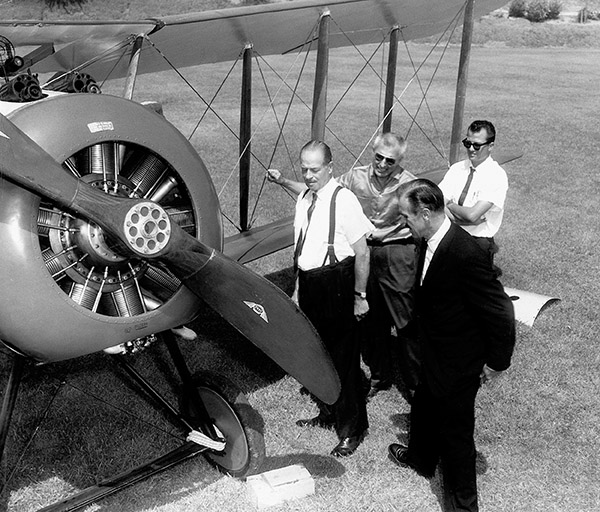
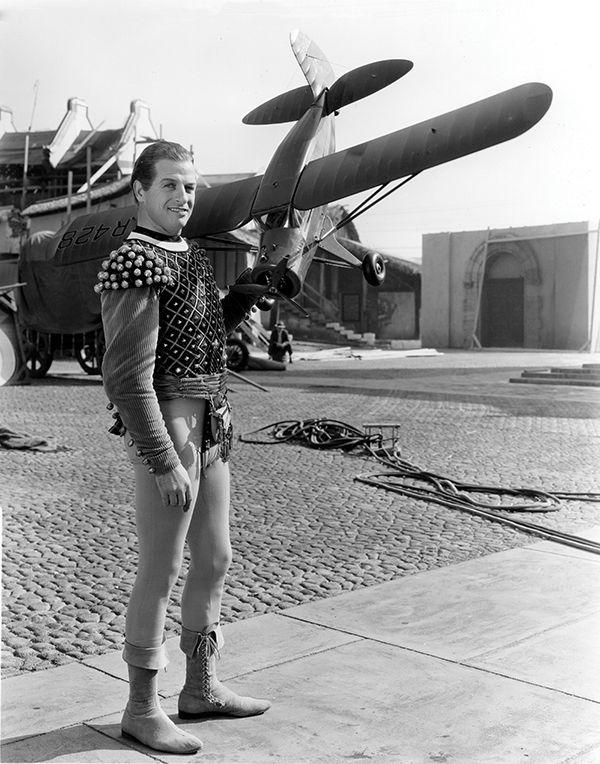
Following the historic run of My Fair Lady, Reg returned to Los Angeles for another honorary celebration, when his namesake star was laid on the newly formed Hollywood Walk of Fame, only a mile from where he had opened his original hobby shop 25 years before. Not only had he made aviation history, but Reg made cinematic history for having one of the longest careers in show business, starring in 200 films during the course of 50 years.
During Reg’s star celebration at the legendary restaurant Musso and Frank Grill, Northrop’s Jules Plummer invited his old boss to get a glimpse of how far his dream had come. Whitley had died and, under its new leadership, the Radioplane Company became Northrop Corporation’s Unmanned Aerospace Systems Sector.
Production of the target drones moved from the 70,000-square-foot plant at Van Nuys Airport to Northrop Ventura’s new 538,000-square-foot facility in Newbury Park, California. As he’d proposed 25 years before, Reg’s Radioplane had been perfected as "aerial torpedoes," with cigar-nosed jets for high-speed antiaircraft and missile target practice. Not only had his vision of aerial torpedoes become a reality, but Reg’s dream had taken off with the US space program. NASA used the unmanned devices for testing aircraft in space, and Reg was bemused to see his Parachute Landing System enlarged to huge 130-foot orange and white parachutes for the Mercury, Gemini, and Apollo Earth Landing Systems.
Reg got another surprise when he located one of his long-lost Snipes. He had loaned this biplane to the Los Angeles County Museum and had lost track of it while developing his drones. Aerospace engineer Jack Canary found it rusting away at March AFB in Southern California, and restored the vintage aircraft to pristine operating condition. Reg made one last sentimental flight before donating the historic warbird to the Canada Aviation and Space Museum.
Happy to see his visions of the past restored, Reg brought the curtain down with his final performances in the first Batman film, then with Frank Sinatra in Assault on a Queen, and in Academy Award-winning Cat Ballou. After attending his last Academy Awards ceremony, Reg was admitted to the Motion Picture Hospital, where a naval officer surprised him with a visit.
Mentored by the UAV pioneer at the onset of WW II, the officer had gone off on an aircraft carrier to train soldiers in the art of drone warfare, then to South Korea, and finally Vietnam. The veteran gifted Reg a wooden propeller of the RP-71 Falconer, which the legendary actor autographed and handed back, thanking the officer for his service.
Reg died in England on June 16, 1967. The Royal Air Force honored its veteran with a flyby over his childhood home, and the Canadian Air Force flew his Snipe for a final flight before retiring it to the WW I exhibit in its museum. A couple of years later, on my birthday, Apollo 11 used Radioplane’s Parachute Landing System to slow the blazing aircraft as it entered Earth’s atmosphere, bringing our first moonwalkers safely back home.
Throughout the 1970s and ’80s, the US military and allies in 24 nations continued to order Northrop Corporation’s unmanned devices. In 1990, the company closed its Ventura facility and relocated its unmanned systems manufacturing to Palmdale, California, with its aerospace headquarters in Redondo Beach, California. In 1994, Northrop Corporation acquired Grumman Corporation, still known today as the world leader in global security and unmanned systems.










2 comments
Reginald Denny
Thank you for your comment Mr
Add new comment